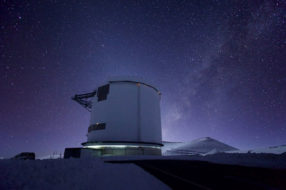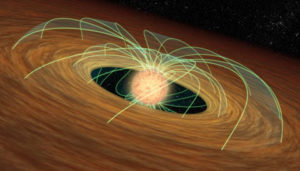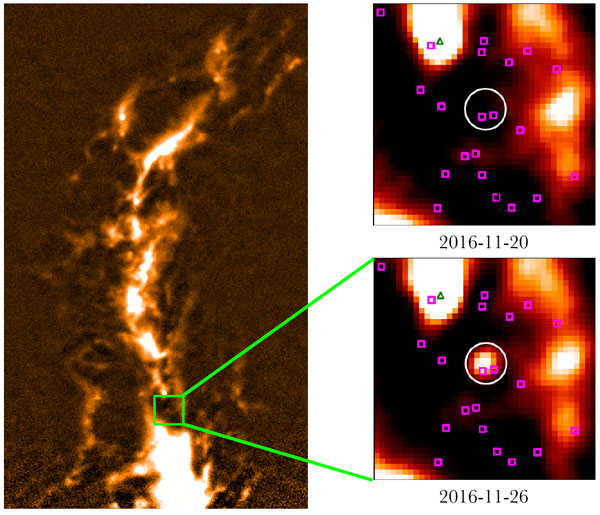Scientists have caught a powerful flare of submillimeter-wavelength radiation from a young star in the Orion Nebula.

Will Montgomerie
A research team using the James Clerk Maxwell Telescope (JCMT) has discovered the first stellar flare at submillimeter wavelengths — one that is 10 billion times more powerful than flares from our Sun. This finding, published January 20th in The Astrophysical Journal, can help scientists better understand the processes by which young stars form — and perhaps reveal our Sun’s history.
“The JCMT Transient Survey seeks to observe events wherein the luminosities of young stars vary,” explain lead author of the study Steve Mairs (East Asian Observatory, Hawai‘i). On November 26, 2016, his team detected the powerful submillimeter flare from a young star forming 1,500 light-years away in the Orion Nebula. That region of the sky hadn’t demonstrated any activity just days before, and during the half hour that scientists observed the flare, its brightness faded by 50%. The whole event probably lasted only a few hours.

NASA / JPL-Caltech
The explanation for this sudden, brief burst of energy lies in the process of star formation. Stars form in large clouds of gas and dust. Each developing sun gains its initial mass by gravitationally pulling in material from its surroundings. But since the 1990s scientists have gained evidence that this may not be a steady process, where material continuously falls onto the central object. Rather, the gas and dust first falls onto a large circumstellar disk, which transports it to the central region of the forming solar system. Ultimately, a powerful magnetic field funnels the material onto the star.
In the system dubbed JW 566, the astronomers think that the young star is spinning faster than the disk feeding it, which twists magnetic field lines around the star. When the field lines can’t twist any further, “this field experiences what is known as a ‘re-connection event’ where field lines twist, break, and reconnect, energizing charged particles and creating an impressive flare,” Mairs explains.
Such an event probably happens numerous times in the process of every star’s formation. After all, stellar flares have been detected at X-ray, infrared, and radio wavelengths. However, this is the first time flares have been observed in the submillimeter range.
“This work shows that such events occur at even earlier times when the star is so deeply embedded in its ‘cocoon’ that it cannot be seen in the optical or infrared and only in the far-infrared," says Jonathan Williams (University of Hawai'i), who was not involved with the study. "This tells us that the dynamical mechanisms that cause these outbursts start right when the star starts forming.”
Mairs adds that the finding was quite unexpected. “We simply happened to be looking in the right direction when we observed the flare,” he explains. “The serendipitous nature of the data actually suggests that events like this may be common. Until now, they have been missed because no one has done a systematic, consistent survey for variability events in nearby star-forming regions at submillimeter wavelengths.”

Steve Mairs
The JCMT survey ends in about a year, and the team hopes to catch at least one more flare by then. Analyzing the flares and why they happen can provide important answers to “questions that are close to home in many people's hearts, such as the origins of planets like our own,” says Mairs. For example, stellar flares are thought to erode atmospheres — and the chance for life — in planets around low-mass stars like Proxima Centauri.
Ilse Cleeves (University of Virginia), who was not involved in the study, agrees that the finding is important. “Characterizing extreme flares such as these are essential in understanding the environments that planets form from,” she says. “We often talk about how flares on stars might impact the habitability of existing exoplanets . . . It is just as important, however, to ask how powerful flares from very young stars can influence whether planets can even form in the first place.”
 1
1
Comments
Nels F
February 22, 2019 at 7:58 pm
Good article but I wouldn't worry about the flares eliminating original atmospheres. Those are accreted atmospheres anyway, not suitable for life probably. Earth of course lost its accreted atmosphere from strong stellar winds if not also flares. It's next atmosphere was the product of outgassing.
You must be logged in to post a comment.
You must be logged in to post a comment.